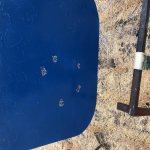Tom figured the price would be the same as the normal barrel. I might try the 60 grain ammo if I can find some. But I believe there will be an advantage shoot the 40gr with more twist. Time will tell.
Platform is a cz455 that I’m building for CRPS.
Joe
I won't get into a pizzing contest over twist rates with 22 rimfire ammo.
So much has changed since inception during the black powder era.
It's now possible to walk into a gunshop and take your pick of a half dozen or more brands, loaded to different velocities, bullet weights, gilded bullets of lubed lead, aluminum cases or brass, the list goes on and on.
There is one thing that has changed as 22 rim fire evolved and that is bore diameter.
One type of rifle I really like are Martinis. I have a couple, made in the twenties, chambered for ".220 Long Rifle"
I never really paid much attention to that stamp. I was just happy they shoot as well as they do. A decade or so back, I actually decided to check the diameter of the bores on those lovely rifles. They really are .220 diameter. The other rifle I was using at the time had a .223 diameter bore and didn't shoot nearly as well.
Saami specs show .225 mean bullet diameter with a +- tolerance of .004 and bore mean diameters of .222 (I've yet to find one at .222)
Most 22rf bores today are .223-.224
My BRNO #2 slugs out at .223 and my new Tikka T1 slugs out at .2235. The old Cooey Ranger slugs out at a very consistent .224
Back when the Martinis were built, bore diameters often varied a few thousandths one way or the other from mean spec. Mine are on the low side but I would assume this is done on purpose, by the stamping on the barrel.
Another thing about that period, plated bullets for 22 rimfire ammo wasn't commonly available and likely not available at all. They may have used harder lead for match grade bullets or maybe the lead alloy specified for the period was harder all around and they needed a reduced bore diameter to make sure the bullets were obturating into the lands.
It could just be that bullet diameters were so erratic back then that the bores were purposely made on the small side, so they would be accurate with all of the different 22rf available at the time.
When I was a kid, over sixty years ago, almost every shop in town sold 22rf rifles. Grocery stores, gas stations/garages, hardware stores and of course sporting goods stores. They all sold 22rf ammo. It was available in short/long/long rifle and most or the late model rifles at the time were so stamped. All of the shops carried one brand of 22lr and that was CIL and it came in many different variants.
This thread has got me thinking. Now I'm going to round up as many different types of 22rf ammo as I can easily find and measure their exposed bullet's, diameters.
I'm suspecting the reason for the larger 223 - 224 bores we commonly find on late manufacture 22rf rifles are to accommodate "plated" bullets???
Funny thing though, my T1 prefers the lubed lead bullets to plated bullets. They both shoot very well in my rifle but the lubed lead shoots just a bit better.
My Martinis could care less if the bullets are plated or lubed lead, they could care less which company manufactured them or the bullet weights/velocities. They shoot everything well, even that Imperial stuff handed out by the DND back in the day for DCRA shooting.










































































